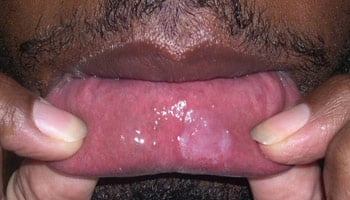Men who have sex with men (MSMs) have been the leaders of the last 3 syphilis epidemics. This current one started in 1997 in the western states. I noticed it in San Diego, and I continued seeing more MSMs with syphilis so that we were seeing at least one a week in our practice.
 Syphilis is caused by a treponeme, a corkscrew shaped bacteria that swims in a corkscrew motion. It can be passed between mucus membranes (the red or pink linings of the holes of your body, not the dry skin). Sometimes it is passed from mucus membranes to skin. (Mucus is produced by these membranes so they don’t dry out. Skin has dead skin cells on top that are already dry, keeping the underlying tissues moist.)
Syphilis is caused by a treponeme, a corkscrew shaped bacteria that swims in a corkscrew motion. It can be passed between mucus membranes (the red or pink linings of the holes of your body, not the dry skin). Sometimes it is passed from mucus membranes to skin. (Mucus is produced by these membranes so they don’t dry out. Skin has dead skin cells on top that are already dry, keeping the underlying tissues moist.)
Back to syphilis: it travels to the lymph nodes and into the blood. Your body produces antibodies to flag the bacterium to be destroyed by the white cells but this strategy is usually ineffective. Like in fighting HIV, antibodies are totally ineffective.
The entry wound on the lips, inside the mouth, labia, inside the vagina, around or inside the anus, and on the scrotum is painless so people don’t look for it but it may be noticed by another person or a medical provider (who are usually a person also) looking at the outside area. This is primary syphilis.
With a painless, unknown sore, the bacteria are transmitted easily to the next person during contact. This sore and maybe some swollen lymph nodes near the area are evident 2-6 weeks after contact.
Secondary syphilis occurs when the sore heals and the treponeme multiplies many times in other tissues. The cardinal sign of palm and sole rashes along with the rash on other parts of the skin cause the medical provider to think of syphilis. It can affect the mouth, eye, and cause general weakness and fevers. You can lose patches of hair in the scalp too.
After the rash, tertiary syphilis becomes known, sometimes years later, by invasion of the brain or the large arteries. Brain syphilis can cause people to behave differently and not be themselves. This stage can last for many years!
Diagnosis: We have discovered unsuspected syphilis upon routine blood testing or when a patient desires a check up for sexually transmitted diseases. We discover it more by testing those who follow the prevention strategy below.
A spinal tap or X-rays may be needed to find the infection inside your body.
Prevention: You will notice that I put prevention before treatment since prevention is much better than having syphilis. If a person is not in a monogamous relationship or wonders if their partner is stepping outside that relationship, then a yearly blood test is a good idea and then treatment if found to be positive. This strategy will prevent the second and third stages. If a person had contact with a new partner, then a blood test a few weeks later is a good idea. For those continually having different partners a blood test every 4-6 months is probably a good idea. Remember that syphilis, warts, and herpes are not just in the urethra (the tube in the penis) so a condom isn’t that effective in preventing these three sexually transmitted diseases like Chlamydia and gonorrhea.
The public health department wants to know the sexual contacts of those who have syphilis since it infects about 30-50% of those contacts (this is very high meaning it is very contagious). They call and say you have had contact with someone who has syphilis, but don’t reveal the name of the other person. You should get tested since this initially painless disease is so easy to pass on to you and from you to others.
If you have had syphilis before, then you will probably always have a positive antibody test in your blood, but the titer or how strong the antibody response tells your medical provider if you have improved, not improved, or gotten a new infection. We usually see the antibody level, or titer, go down over 6-12 months; so you don’t even know if you are better for quite a long time.
Treatment: Syphilis is not resistant to penicillin in high doses, so far. For primary syphilis it takes 1 large injection of long acting penicillin in one buttock or half of it in each buttock since it is painful but not intolerable. For secondary, the same treatment, but given three times, delivered once a week.
For tertiary syphilis, a different form of penicillin injection is given each day for 2 weeks plus some pills to take just before and after to boost the tissue levels of the penicillin; intravenous treatment gets better results but must be done in a hospital usually unless your insurance pays for a home nurse to put in a long IV line and has a computer assisted IV pump.
HIV patients have it a little worse. Their immune system is impaired and it is harder to cure syphilis so we treat them more aggressively and we check their blood test regularly too.
Once again, abstinence or mutual monogamy is the best prevention.

